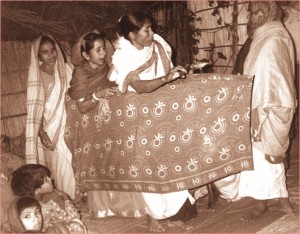| Cover Story
From Rangpur
The Snake Litanies
Saimon Zakaria visits Rangpur to find out an unusual twist on the Manasa Sangeet tradition.

About ten kilometers to the south of Rangpur, in the village of Fatehpur the widows have a tradition of singing these songs about Manasa, or snakes. It is said that not everybody can appreciate this art. After receiving the letter from my friend Nurunnabi Shanto, I got the strong desire to go and see this performance by the widows. I was particularly excited because I had never before seen women perform this Manasa Mangal ritual. And yet, Manasa naturally seems like a woman's territory. But in the performances that I had seen before, there were no actual women. The female roles were played by men. So why were the women of Rangpur an exception? A hundred possible explanations came to my mind; I couldn't decide. I couldn't wait to visit Fatehpur village. But the first thing on my pre-set itinerary was visiting Pirojpur, Bagerhat. My Rangpur trip then, had to come later.
Royani:
 I was now at Shoulkhali village of Morelganj thana in Bagerhat district. There I met Royani master Manoranjan Dakua and a managed to get an invitation to see a Royani performance in a couple of days. The show was to be held in Jantardik village. Manoranjan's Royani group's name is “The Sri Meera Group”. Meera Rani Mistry was the group's lead. I learnt that women were the main performers here. The men have been marginalized in the roles of the instrumentalists. Men sometimes do act, but only in fairly small roles. The whole thing seems to be about women, very much on purpose. Besides Meera Rani Mistry, the two other singers of the group are Maya Rani Boiragi and Ujjala Saha. I was now at Shoulkhali village of Morelganj thana in Bagerhat district. There I met Royani master Manoranjan Dakua and a managed to get an invitation to see a Royani performance in a couple of days. The show was to be held in Jantardik village. Manoranjan's Royani group's name is “The Sri Meera Group”. Meera Rani Mistry was the group's lead. I learnt that women were the main performers here. The men have been marginalized in the roles of the instrumentalists. Men sometimes do act, but only in fairly small roles. The whole thing seems to be about women, very much on purpose. Besides Meera Rani Mistry, the two other singers of the group are Maya Rani Boiragi and Ujjala Saha.
Before the performance, in the dressing room, I ask Master Manoranjan Dakua and Meera Rani Mistry, “Why is your team made up of women?” Manoranjan slyly replied, “It's forbidden to sing these songs by anyone but women.”
Now I ask, “why?” Manoranjan replies, “because it is not possible to sing these songs without women.” Meera Rani Mistry interjects, “Can a man ever understand suffering in the way that a woman can? No, he can never understand it. Royani is the music of Manasas. It is the music of Behula.” At Meeradi's words I come back to the topic of Manasa, she seemed to make perfect sense. Of course, the songs were about the two women- Manasa and Behula. Both of these women have had to overcome many obstacles to be well respected in society. Men do not understand the pain and anguish these women have had to go through.
One woman has many forms-the mother, the daughter, the sister. Never before in any performance had I seen all these forms of Royani women singers. The whole performance was about the self-image and self-perception of these women. In that way, the show was kind of autobiographical.
The Songs of the Widows:
After a long journey, I finally reached Rangpur. On a beautiful full-moon night, out on the little courtyard we settled down for the performance in the bone-chilling cold. We were hit with a surprise right in the beginning. Never before had I seen such a simple performance. There were no fancy flourishes as I would have expected. In one spot, the wood had been chopped off to make way for a musical instrument made out of tin. There are no other instruments in sight. It is noteworthy that the performers made this themselves. This is quite a peculiar instrument using wood and metal. It was unlike anything I had seen before and quite a unique experience for all the listeners. It was kind of a substitute for a local castanet.
We notice that in the Bishahari songs, the whole performance is about singing and dancing. And throughout the performance the women of the whole village tirelessly performed the whole night, but in a manner as mundane as their lives. There were no frills. It seemed as though the show was inseparable from their lives- it was nothing special. For these women, performing is not much different from doing everyday chores like cooking. They all routinely get up to make rafts out of tree trunks as if they have done this many times before. Behula and Lakhshmindar get up on the raft and sail off. Lakhshimdar had been bitten, and bite victims must be put on a raft and sent away. Behula accompanied him as a perfectly virtuous wife. At this point in the performance, we feel the pain of Behula.
The story of Behula is well known in Bangladesh. But this performance opens ones eyes to other things. Other sociocultural aspects come through in the way the performance unfolds, that one cannot understand from just casually hearing about the story. My experience at Rangpur was unique. The evening did shed light on the lives of these women, what songs mean to them and their lives.

Copyright
(R) thedailystar.net 2007 |
